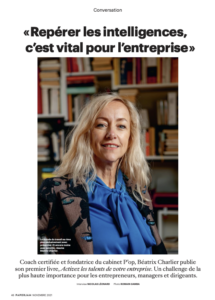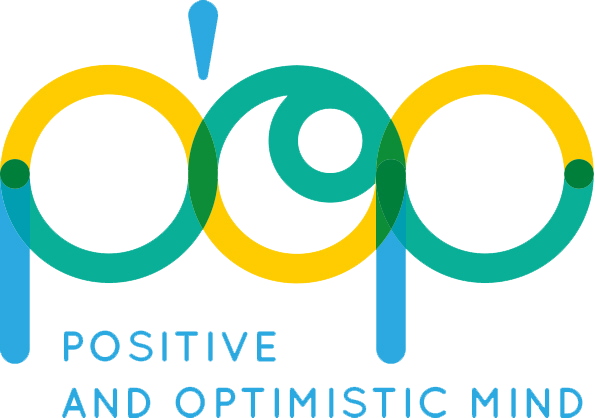
Conversation with Nicolas Léonard on the occasion of the release of Béatrix Charlier’s first book, “Activate Your Company’s Talents”.
One of the first chapters of your book, published by L’Attitude des Héros, resonates as a warning and could alarm some business leaders: your company is built on flaws. What are these flaws?
Béatrix Charlier. – “These are what many are familiar with in their professional environment, such as the silo system for categorizing employees, the dominance of diplomas over skills, hierarchy by titles, and the system of bonuses and rewards linked to the sacred annual evaluations… However, ultimately, we observe that all of this undermines engagement, I would even say, almost extinguishes it.”
Why, before the company’s responsibility, do you highlight that of the school?
“The educational world operates in a closed system, with methods of guidance, validation, and evaluation, and a recognition of skills and qualifications that are no longer adapted to today’s world. The school remains convinced that its role is to transmit knowledge. But since this knowledge is accessible via phones, social networks, and websites, what matters is its usefulness, meaning, and relevance. This, in addition to the fact that pupils and students are rarely involved in the construction of knowledge, leads to academic disengagement. It also leads to the deterioration of family relationships and suffering.”
And does the school system influence the company?
“Yes, it is evident. The goal of general education is to lead to a university and a higher education institution, which, by awarding qualifications and diplomas, must lead to the world of work. All of this is done through a hierarchy and awarded qualifications: the keys to progression. And the race for qualifications then continues in the professional world, becoming a social barometer.”
However, particularly driven by Generations Y and Z, many employees no longer identify with the structure proposed by the company, its hierarchy, or the way one can progress within it…
“This is what is called ‘disengagement’: people do not want to integrate into the structure, they no longer find their place there, and they leave it because they find it unsuitable. However, companies are obliged to adapt because, for the first time, we have four generations present simultaneously who must coexist and have different expectations.”
Is the common denominator within the company, for everyone, the search for meaning?
“It is an aspiration that comes from millennials, but which most employees have adopted. Both at the company level and in their private lives. The right to manage one’s time freely, flextime, remote work, abolition of rigid hierarchical structures, work-life balance—all this in a world where everything moves faster… Companies must take this into account, or risk facing serious consequences.”
With, as the main symptom of this malaise, significant employee turnover…
“Indeed. The traditional promises made by companies to retain talent, such as salaries, benefits in kind, and career progression, are no longer sufficient to retain Generation Y employees, and these employees are challenging the other components of these companies. Those that succeed in retaining their employees are those that have understood autonomy and embody strong, shared values.”
A CEO is needed who has no ego issues and does not pursue a scorched-earth policy. Unfortunately, too many CEOs want to be superior and shine even brighter.
Departures are compensated by recruitment, but is this no longer the solution either?
“In the past, recruitment was done to improve performance, to meet very specific needs. Now, we must look at things differently and analyze the entire human capital of a company. My book opens this path: instead of putting a lot of energy into job descriptions and job interviews, why not first identify talents within one’s teams, recognize multiple intelligences, activate them, and optimize performance? We are all different, but we all have talents stemming from our multiple intelligences. Now, identifying intelligences is vital for the company.”
Are companies therefore operating below their potential because management fails to identify dormant talents and recognize multiple intelligences?
“It’s like your smartphone: you use 25% of its capacity, just like your brain. However, our companies are much richer in talent than they realize, and it is these talents that will drive the company’s evolution. But for this to happen effectively, a CEO is needed who has no ego issues and does not pursue a scorched-earth policy. Unfortunately, too many CEOs want to be superior and shine even brighter. The same applies to managers who do not necessarily want to see their team grow, for fear of being surpassed.”
Are CEOs, decision-makers, and business owners simply afraid of acknowledging failure, namely: should they have activated talents instead of recruiting extensively to compensate for departures?
“The CEO is always afraid. It is part of a CEO’s life: fear of being overwhelmed, fear of missing a step in the company’s evolution… Yes, it is difficult to acknowledge failure. But what is more serious is that they do not have the time to do so. A CEO should work part-time, having 50% free time in their schedule.”
To do what? To think! Unfortunately, their agendas are 150% full. They therefore do not have the luxury of telling themselves that they will analyze recruitment, engagement rates, disengagement rates, how to do better than in recent years… I know few CEOs who do this. The key is time, we know that. When I advise holding a weekly meeting to discuss this or that, I am often told that there was no time to do it last week because there was an emergency. I then reply that the emergency, the real emergency, is you and only you!
Generations Y and Z, in particular, and their search for meaning, are destabilizing, challenging, and demanding… They are a little frightening, but can they be a source of inspiration?
“There are two attitudes one can adopt. Either a closed-minded attitude, and then one looks at these generations asking: “Who do they think they are? They won’t be so smart when they have a loan to pay off every month.” Or one can adopt an attitude of understanding, admitting that what they want, we would have wanted too. One then wonders if what was sacrificed was worth it.”
And in that, there is also danger for the company…
“Because this also leads to turnover among Generation X executives and managers, and that is much more damaging, as it creates significant gaps in structures. All of this is ultimately organic; Generation Y came with the search for meaning about ten years ago, and now we are all asking ourselves about meaning. Generation Z came with the question of commitment to the planet, its salvation, and we will all shift and embrace these values. Ultimately, they are the ones redefining the model of life, determining what is important, why we get up in the morning… And I believe these are indeed inspiring elements.”
But these generations are more complex to manage. How can one engage them and align them with one’s objectives?
“Unfortunately, it doesn’t work like that. The manager has their own conception of meaning, and the person they hire has their own meaning, but will not adhere to the manager’s with a snap of the fingers. In any case, directive management is dead because authority is no longer recognized.”
What then are the ways to foster engagement and encourage creativity?
“People need to be involved from the start of the project, to see if they are on board or not. There’s no point in expending energy to get people to commit to a project that means nothing to them: they don’t even want to. I often advise bringing employees to the table, explaining the project, asking for everyone’s opinions, ideas, and impressions… Arriving and saying that there’s a great project, that everyone needs to get to work to deliver it in 15 days, and clapping hands saying “go!”, no longer works.”
Personally, asserting nowadays that everyone needs to be in an open-plan office to work together, makes me laugh! It doesn’t work!
Two concepts then appear central in your book: the ‘why’ and ‘care’. How can they be characterized?
“The ‘why’ is the keystone: giving meaning is more than paramount, it is vital! Care is the cement: listening, attention, facilitating the free flow of talent, supporting developments, and responding to requests.”
Is it ever too late to do things right? Are some companies so entrenched in a mode of operation that it will be impossible for them to break free and evolve?
“No, never, but on one condition: to gain perspective. If one is too closely identified with their company, it is very difficult to initiate changes.”
Is this detachment also necessary in the context of a business transfer?
“Absolutely. But it is not simple, because transferring one’s business means ending a story. This directly refers to our own finitude.”
So, this question of succession is raised…
“…too late, obviously. Always too late. Business transfer should be prepared ten years in advance.”
Whether this succession is intra-family or not?
“It doesn’t matter. It is the person transferring who must prepare by asking themselves these questions, in particular: When will this end? What will I become? What will my life be? Am I capable of living outside this frenzy, this stress? What else can I do? Now, I concede that it is sometimes more complicated in the context of a family business, because there is a certain weight, a legacy, the fear of others’ judgment…”
How do you see the future evolutions of the professional world in connection with remote work?
“We don’t know what companies will be like tomorrow! But we can observe a number of phenomena such as a deterioration of relationships, because people are no longer together. Some have also strayed from their company’s objectives and thought only of their comfort: these individuals no longer want to return, but prefer to stay where they are… Others also resign for good or bad reasons, but others return because they like it. In any case, Covid has opened up an incredible field of freedom! Managers must know that “total control” does not work. Those who want timesheets at the end of the day are best placed to observe this, as they never receive them 100%. Personally, asserting nowadays that everyone needs to be in an open-plan office to work together, makes me laugh! It doesn’t work!”
Was writing this book dictated by the urgency of the moment?
“There are two elements. First, I train coaches in my tools, and they were asking for a written resource. Second, when the lockdown arrived, and my schedule was completely cleared in three days, I, I’m not ashamed to admit, collapsed. My company was four years old; I saw it taking off, and all of a sudden, there was nothing… However, I didn’t want to give up. I saw businesses around me closing, and I found that unbearable. It was therefore time to understand how it was possible for businesses to collapse like that, ‘just’ because of a lockdown. The goal was not to write for the sake of writing, but to help.”
But, ultimately, is it a book that encourages questioning, rather than offering ready-made solutions?
“I deliberately designed it this way, with questions at the end of each chapter. I don’t believe in recipes or ready-made solutions. In my opinion, we progress with the right question, but how difficult it is to find the right question! If this book helps to define it, all the better.”
The book is available at Ernster and Alinéa bookstores, but also via the author’s website or the publisher’s.
This article was written for Paperjam’s November magazine edition published on October 28, 2021.

